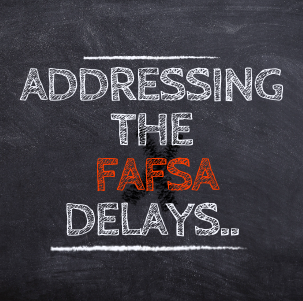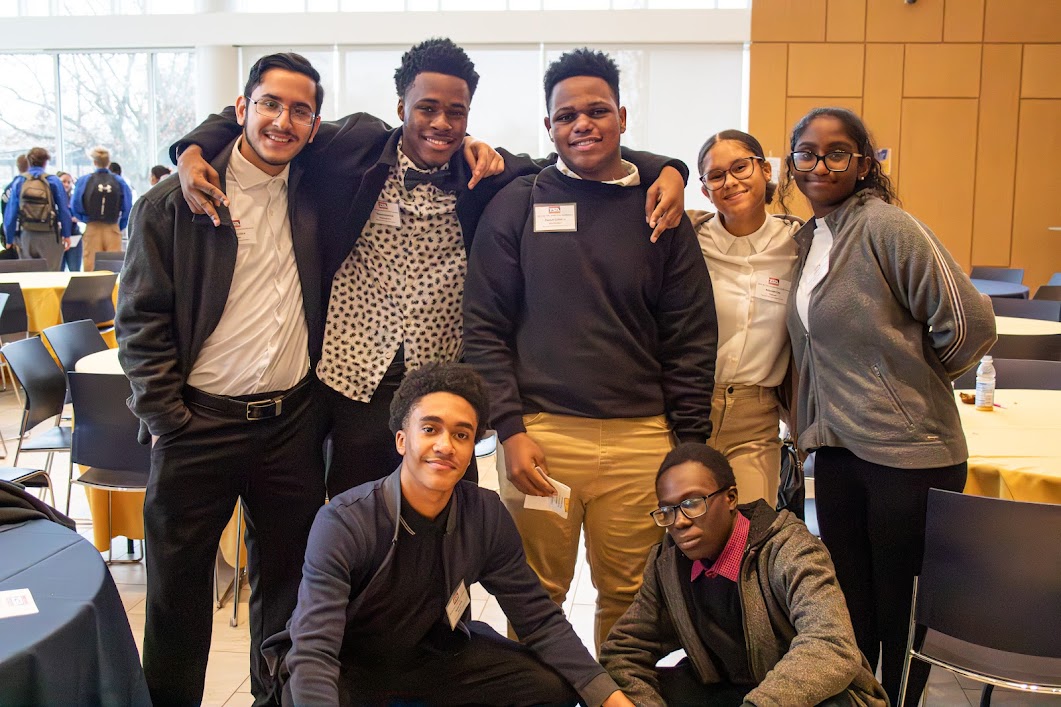The exact publication date of this article will be in the second week during the month of April 2024. The month before the most common nationwide post-secondary institution deadlines to submit an enrollment deposit fee or to fully enroll into that institution. The FAFSA has been delayed ever since, so how did we get here? Last year the Department of Education had failed to meet the October 1st (original) scheduled deadline to open the FAFSA, the delay of the launch was pushed back to the uncertain end of December of 2023.
Finally launching on Dec. 31st through a soft launch period due to major outages and maintenance that took place on the site throughout the month of January. These scheduled outages allowed the site to provide a beneficial and efficient user experience for both students and families. Leaving with many people equally unable to fill out the forms, log in, create a FSA ID, and resume work on the forms.
Amid the ongoing delays as the Department of Education continues to address the failures of the newly made FAFSA site and form, other deadlines have begun to cause widespread disarray. College FAFSA submission deadlines were commonly requested earlier in the year and expected to be met, yet with the delays of the forms processing, institutions found themselves unable to verify or prioritize their financial aid package deadlines. Pushing deadlines or erasing them for the time being. State deadlines also have to be met with the state of New Jersey’s 2023-2024 Tuition Aid Grant Recipient application deadlines due April 15, 2024, and other applications for the fall or spring terms required by Sept 15, 2024. With the federal government stating that the FAFSA form is to be submitted by midnight on June 30th, 2025 for the 2024-2025 school years. With the 2023-2024 form due by June 30th, 2024.
Many institutions around the country have addressed this issue and further provided electronic mail and formal letters to state their concerns and the actions they have taken. Aside from pushing back deadlines and possibly even their enrollment deadlines, FAFSA’s processing delays continue to roam into the crucial month of April; peak season for many institutions. With the predicted and widely expected return of these forms to institutions to finally prepare financial aid packages to be mid-late April, which can be weeks or days before enrollment deadlines. Panicking yet? Theres much more to what is going on with the FAFSA delays and chaotic changes that can also be addressed as a political issue and failure by the United States.
So What Is The FAFSA?
The Free Application for Federal Student Aid (FAFSA) is a crucial form for students and their families in the United States who are seeking financial assistance to pay for higher education. Essentially, the FAFSA is the gateway to receiving federal financial aid, including grants, loans, and work-study opportunities, as well as some state and institutional aid.The FAFSA form itself is an application that collects detailed information about a student’s and their family’s financial situation. This includes income, assets, household size, and number of family members in college, among other factors. The information provided on the FAFSA is used to calculate the Expected Family Contribution (EFC), which determines a student’s eligibility for various types of financial aid.Students and their parents or guardians typically need to fill out the FAFSA form together. The form is required for anyone seeking federal financial aid for higher education, including undergraduate and graduate students. This includes those attending college or university, vocational or technical school, or graduate school.
Both students and parents must complete the FAFSA because:
- It is primarily used to determine eligibility for federal financial programs, whether that be Pell Grants, Federal Loans, Work-Study initiatives, and much more.
- States and institutions will use the FAFSA to determine eligibility for their own programs, such as scholarships and grants based on financial need.
To also address the definition of a “Contributor” which is referring to relatives asked to provide their information, consent and approval to have their federal tax information sent from the IRS to the FAFSA form, followed by a signature.
Key Differences Between The Previous FAFSA Forms
Before addressing the key differences, it should be noted that when filling out the FAFSA you must understand which forms to fill out and why. If attending a college or trade school on the dates between July 1, 2023, and June 30, 2024, fill out and complete the 2023-24 FAFSA form. If attending college or a trade school in the dates between July 1, 2024, and June 30, 2025, complete the 2024-25 FAFSA form. If attending college or trade school during both periods of time, complete both the 23-24, and 24-25 FAFSA forms. If attending summer classes make sure you contact your school’s financial aid office to see which form you should complete.
The major difference between the previous FAFSA form and to the current one is that their are a reduced number of questions and input information, from more than 100 to 40, and can be completed in just 15 minutes. The newly designed application is also available in 11 more languages compared to the previous English and Spanish versions.
FSA IDs are a mandatory aspect of the form and should be done before accessing the form, every contributor must create a FSA ID. Parents without a SSN can now create a FSA ID as well, followed by additional steps towards the verification of their identity.
More changes such as with the ‘Need Analysis Formula’, more access to Pell Grants, required consent for IRS data to transfer over to FAFSA via IRS data retrieval tool, the Student Aid Index replacing the EFC, and much more to follow.
The Goal Of The New FAFSA
The goal of the newly created and easier-to-complete FAFSA for the 2024-2025 school year is to streamline the financial aid application process, reduce barriers to access, and increase participation among students and families.One of the key objectives of the updated FAFSA is to simplify the application process, making it more user-friendly and less daunting for applicants. This entails redesigning the form layout, revising confusing language, and providing clearer instructions throughout the application. By improving the overall usability of the FAFSA, the aim is to reduce errors and incomplete submissions, ultimately expediting the processing time and ensuring that eligible students receive their financial aid in a timely manner.
Furthermore, the newly revamped FAFSA aims to leverage technology to enhance accessibility and convenience for applicants. This includes optimizing the FAFSA for digital platforms, such as mobile devices and online portals, to accommodate the preferences and lifestyles of today’s students and families. By offering a seamless and intuitive online application experience, the goal is to encourage more individuals to complete the FAFSA and access the financial assistance they need to pursue higher education.
In addition to improving usability and accessibility, another objective of the updated FAFSA is to better align with the diverse financial circumstances of students and families. This involves implementing more personalized and targeted questions to accurately capture each applicant’s financial situation. By collecting relevant data specific to individual circumstances, the goal is to provide more tailored and equitable financial aid packages that reflect the unique needs of each student.
Moreover, the revised FAFSA also aims to increase transparency and awareness of available financial aid resources. This includes providing detailed information about different types of financial aid, eligibility criteria, and application deadlines to help students and families make informed decisions about their educational financing options. By empowering applicants with comprehensive knowledge and resources, the goal is to foster greater financial literacy and facilitate more strategic planning for college affordability.
The Real Reason Behind The FAFSA Delays..
To put into perspective, there is no true easier solution towards FAFSA itself. The main goal here is to determine student eligibility and the ability to afford post secondary education, with many students being dependents it also means that the students income or savings will also be accounted for following their guardian’s income or savings. Regardless of this it will not properly account towards the actual wealth of a family, yet the FAFSA has made it where they want families to instead split and assign their joint incomes and wealth into individual percentages.
In the first week of March a challenge was presented to the nation as a “three-day crash effort” was taken by dozens of department employees in response to the discovery of tens of thousands of unaccounted emails that contain necessary data, untouched. Another and the very first setback was the uncertain rollout of the newly implemented FAFSA site and form that was ordered to be revamped and made more accessible by U.S Congress 3 years prior. In simple terms, this has been a bureaucratic nightmare, for the surface world, it leaves millions in a blunder during the most crucial stage in the 2024 college admission process.
Institutions at this point do not have and couldn’t receive the financial information and eligibility remarks the application would’ve processed, postponing decisions, events, enrollment deadlines and pushing back those deadlines to better suit the necessary time being taken, worsening wait lists, and budgets. On the week of March 10th, 2024, the Dept. of Education established their own self imposed deadline by Friday March 15th, 2024.
Nearly 10s of millions of applications continue to roll in once the process is being dealt with, which is far more monumental than previously thought. The site pulled through from “technical malfunctions” and fluctuating time outs, it stalls the progress as the government cannot calculate federal aid towards students without this necessary data.
An investigation was launched to get to the bottom of the delays as several officials from the White House privately spoke on the matter, with complaints aimed towards the contractors involved in the development and deployment of the new FAFSA platform, as the contractors missed said deadlines and lacked vital resources that were mostly exhausted towards reopening schools and repayments following the Coronavirus pandemic. A company said to be one of the contractors which was previously facing rollout challenges during the Obama administration era had a representative state that the questions referring to the complications cannot be answered by them and only answered by the Department of Education. With notable failures such as a lack of actual testing and a genuine status of how the platform will operate, with also the Department of Education failing to adjust a “critical income formula” – NYTimes.
So What Now??
All people can do now is wait and hope for the best but also take opportunities when they can. Students or people pursuing post secondary education should continue to apply to external and institutional scholarships, and find out every way possible to lower costs to attend the institution or trade institution. Institutions around the nation receive technical assistance from the Department of Education’s small task force of staff that are backed by a multi million dollar budget to ensure the swift and closely monitored roll out and handling of FAFSA applications.
Post secondary institutions are beginning to finalize their admissions for the ‘24-25 school year. FAFSA as promised is making it to institutions towards the proposed middle of April weeks before enrollment deposits for universities nationwide. As we speak, many FAFSA applications are processed and being sent to institutions nationwide so the students expect financial aid packages to also make an appearance. Do not shy away from asking questions and keeping close watch of the processing of your FAFSA application and stay alert to how your institution will respond or the steps taken such as providing estimators that were swiftly constructed to provide results based off of your SAI (Student Aid Index). Best of luck to those who read this!





